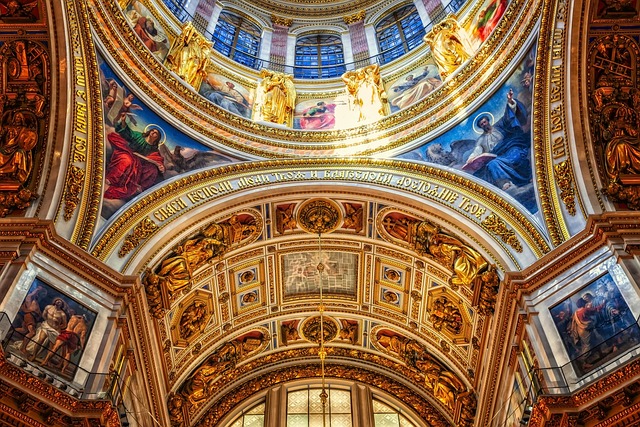Orthodox Catholic refers to the Eastern Orthodox Church, which is one of the three major branches of Christianity, alongside Roman Catholicism and Protestantism. The Orthodox Catholic Church traces its origins back to the early Christian community in the Eastern Roman Empire. With its distinct theological, liturgical, and ecclesiastical traditions, the Orthodox Catholic Church is separate from the Roman Catholic Church, although both share common roots in early Christianity.
Table of Contents
The History and Beliefs of Orthodox Catholicism
Are Orthodox Catholic?
When it comes to religion, there are countless denominations and branches that can sometimes be confusing to navigate. One such branch is Orthodox Catholicism. Many people wonder if Orthodox Catholics are the same as Roman Catholics or if they have their own unique set of beliefs. To answer this question, we must delve into the history and beliefs of Orthodox Catholicism.
Orthodox Catholicism traces its roots back to the early days of Christianity. In fact, it is believed to be the oldest form of Christianity in existence. The word “Orthodox” itself means “correct belief” or “right teaching,” emphasizing the importance of adhering to the original teachings of Jesus Christ and his apostles. This commitment to tradition and orthodoxy sets Orthodox Catholicism apart from other Christian denominations.
One of the key differences between Orthodox Catholicism and Roman Catholicism lies in the structure and organization of the church. While Roman Catholicism is centered around the Pope and the Vatican, Orthodox Catholicism is more decentralized. It is made up of several autocephalous (self-governing) churches, each led by a patriarch or metropolitan. These churches are united in their faith and doctrine but maintain their own administrative autonomy.
Another significant difference between Orthodox Catholicism and Roman Catholicism is the use of icons in worship. Icons are religious images or paintings that are venerated and used as aids in prayer and meditation. In Orthodox Catholicism, icons are considered to be windows into the divine and are used as a means of connecting with God. Roman Catholicism, on the other hand, places less emphasis on icons and focuses more on statues and other visual representations.
The sacraments, or sacred rituals, are also an essential aspect of Orthodox Catholicism. Like Roman Catholics, Orthodox Catholics believe in the seven sacraments, including baptism, confirmation, and the Eucharist. However, there are some differences in the way these sacraments are practiced. For example, in Orthodox Catholicism, infants are typically baptized by immersion, while Roman Catholics often practice infant baptism by pouring water over the child’s head.
In terms of beliefs, Orthodox Catholics hold many of the same core doctrines as Roman Catholics. They believe in the Holy Trinity, the divinity of Jesus Christ, and the importance of salvation through faith and good works. However, there are some theological differences that have led to a separation between the two branches. One such difference is the understanding of the procession of the Holy Spirit. While Roman Catholics believe that the Holy Spirit proceeds from both the Father and the Son, Orthodox Catholics believe that the Holy Spirit proceeds from the Father alone.
Despite these differences, it is important to note that Orthodox Catholics and Roman Catholics share a common heritage and are both part of the larger Catholic Church. They may have different practices and traditions, but at their core, they are united in their love for Christ and their commitment to living out their faith.
In conclusion, Orthodox Catholicism is a distinct branch of Christianity with its own rich history and set of beliefs. While it shares some similarities with Roman Catholicism, it also has its own unique practices and traditions. Understanding the history and beliefs of Orthodox Catholicism can help foster a greater appreciation for the diversity within the Catholic Church and the richness of the Christian faith as a whole.
The Role of Icons in Orthodox Catholic Worship

Are Orthodox Catholic?
When it comes to religion, there are many different branches and denominations that people can choose to follow. One of these branches is Orthodox Catholicism, which has a rich history and a unique set of beliefs and practices. One aspect of Orthodox Catholic worship that sets it apart from other Christian denominations is the use of icons.
Icons play a central role in Orthodox Catholic worship. These religious images are not just decorations or works of art; they are considered to be windows into the divine. Icons are believed to be a way for believers to connect with the saints and with God himself. They are seen as a means of communication between the earthly and the heavenly realms.
In Orthodox Catholic churches, icons are prominently displayed and venerated. They are often placed on an iconostasis, a screen or wall that separates the sanctuary from the nave. This separation symbolizes the division between the earthly and the heavenly realms. The icons on the iconostasis depict various saints, biblical scenes, and events from the life of Christ. They serve as a visual representation of the faith and as a reminder of the presence of the divine.
When Orthodox Catholics enter a church, they will often kiss or touch the icons as a sign of reverence. This act is not worshiping the icons themselves, but rather showing respect and honor to the saints and to God. It is a way of acknowledging the spiritual significance of these images and of seeking their intercession and blessings.
Icons are not only found in churches but also in the homes of Orthodox Catholic believers. Many families have a special corner or area in their homes dedicated to icons. This space is often adorned with candles and incense, creating a sacred atmosphere. Orthodox Catholics will often pray in front of these icons, seeking guidance, comfort, and spiritual connection.
The use of icons in Orthodox Catholic worship can be traced back to the early days of Christianity. In the early centuries, when many people were illiterate, icons served as a way to teach and convey the stories of the Bible. They were used as a visual aid to help believers understand and remember the teachings of the faith. Over time, the veneration of icons became an integral part of Orthodox Catholic tradition and spirituality.
It is important to note that the use of icons in Orthodox Catholic worship is not meant to replace or overshadow the worship of God. Icons are seen as aids to worship, not objects of worship themselves. They are a means of connecting with the divine and seeking the intercession of the saints. Orthodox Catholics believe that through the veneration of icons, they can draw closer to God and experience his presence in a tangible way.
In conclusion, icons play a significant role in Orthodox Catholic worship. They are not mere decorations but are considered to be windows into the divine. Icons are venerated and used as a means of connecting with the saints and with God himself. They serve as a visual representation of the faith and as a reminder of the presence of the divine. The use of icons in Orthodox Catholic worship is deeply rooted in tradition and is a way for believers to seek spiritual connection and guidance.
The Sacraments and Liturgical Practices of Orthodox Catholicism
Are Orthodox Catholic?
When it comes to the sacraments and liturgical practices, Orthodox Catholicism shares many similarities with Roman Catholicism. Both traditions place a strong emphasis on the sacraments as a means of experiencing God’s grace and participating in the life of the Church. However, there are also some key differences that set Orthodox Catholicism apart.
One of the most significant differences between Orthodox Catholicism and Roman Catholicism is the number of sacraments recognized. While Roman Catholicism recognizes seven sacraments, Orthodox Catholicism recognizes a total of nine. These additional sacraments include the sacrament of chrismation, which is the sealing of the newly baptized with the gift of the Holy Spirit, and the sacrament of unction, which is the anointing of the sick with oil for healing.
Another difference lies in the liturgical practices of the two traditions. Orthodox Catholicism is known for its rich and elaborate liturgical services, which are often conducted in ancient languages such as Greek or Church Slavonic. These services are characterized by their use of incense, icons, and intricate chants. Roman Catholicism, on the other hand, has a more diverse range of liturgical practices, with some services being more traditional and others incorporating more contemporary elements.
Despite these differences, both traditions share a common belief in the real presence of Christ in the Eucharist. In both Orthodox Catholicism and Roman Catholicism, the bread and wine used in the Eucharist are believed to become the body and blood of Christ through the process of transubstantiation. This belief is central to the sacramental life of both traditions and is a source of great reverence and devotion.
Another shared practice is the veneration of saints and the use of icons in worship. Both Orthodox Catholicism and Roman Catholicism believe in the intercession of saints and honor them as examples of faith and holiness. Icons, which are sacred images of Christ, the Virgin Mary, and the saints, are used as aids to prayer and meditation in both traditions. They serve as a reminder of the presence of the divine and are often kissed or touched as an act of reverence.
While there are certainly differences between Orthodox Catholicism and Roman Catholicism in terms of sacraments and liturgical practices, it is important to remember that both traditions are rooted in a common faith and share a commitment to the teachings of Christ. The sacraments and liturgical practices are means through which believers can encounter God and deepen their relationship with Him.
In conclusion, Orthodox Catholicism and Roman Catholicism have much in common when it comes to the sacraments and liturgical practices. Both traditions recognize the importance of the sacraments as a means of experiencing God’s grace and participating in the life of the Church. While there are differences in the number of sacraments recognized and the specific liturgical practices, both traditions share a belief in the real presence of Christ in the Eucharist and a reverence for saints and icons. Ultimately, it is this shared faith and commitment to Christ that unites Orthodox Catholicism and Roman Catholicism, despite their differences in practice.
Understanding the Differences Between Orthodox Catholicism and Roman Catholicism
Are Orthodox Catholic?
When it comes to religion, there are countless denominations and branches that can sometimes be confusing to differentiate. One such example is the distinction between Orthodox Catholicism and Roman Catholicism. While both share many similarities, there are also some key differences that set them apart. In this article, we will explore these differences and gain a better understanding of what makes Orthodox Catholicism unique.
To begin with, it is important to note that both Orthodox Catholicism and Roman Catholicism are branches of Christianity. They both believe in the teachings of Jesus Christ and follow the Bible as their holy scripture. However, the way they interpret and practice these beliefs can vary.
One of the main differences between Orthodox Catholicism and Roman Catholicism lies in their hierarchy and leadership. In Roman Catholicism, the Pope is considered the head of the Church and has the final authority on matters of faith and doctrine. On the other hand, in Orthodox Catholicism, there is no single leader with universal authority. Instead, each autonomous Orthodox Church has its own leader, known as a Patriarch or Metropolitan. This decentralized structure allows for more local autonomy and decision-making within the Orthodox Church.
Another significant difference between the two branches is the use of icons and religious imagery. In Orthodox Catholicism, icons play a central role in worship and are believed to be windows into the divine. They are venerated and used as aids in prayer and meditation. Roman Catholicism, on the other hand, also uses religious imagery, but the veneration of icons is not as prominent. This distinction in the use of icons reflects the different approaches to spirituality and worship in the two branches.
The liturgical practices in Orthodox Catholicism and Roman Catholicism also differ to some extent. Both branches celebrate the Eucharist, or Holy Communion, but the rituals and traditions surrounding it can vary. In Orthodox Catholicism, the Divine Liturgy is the central act of worship and is characterized by its rich symbolism and ancient traditions. Roman Catholicism, on the other hand, has its own distinct liturgical practices, including the Mass, which may differ in certain aspects from the Divine Liturgy.
Furthermore, the issue of papal infallibility is another point of divergence between the two branches. In Roman Catholicism, the Pope is believed to be infallible when speaking ex cathedra, or from the chair of Peter, on matters of faith and morals. This means that his teachings are considered to be without error. In Orthodox Catholicism, however, there is no equivalent belief in papal infallibility. Instead, decisions are made collectively by the Church through councils and synods.
In conclusion, while Orthodox Catholicism and Roman Catholicism share a common foundation in Christianity, there are distinct differences that set them apart. These differences can be seen in their hierarchy and leadership, the use of icons and religious imagery, liturgical practices, and beliefs regarding papal infallibility. Understanding these distinctions can help foster a greater appreciation for the diversity within the Christian faith and promote dialogue and understanding between different denominations.
Conclusion
No, Orthodox Christians are not Catholic.
For licensing reasons, we must provide the following notice: This content was created in part with the help of an AI.


